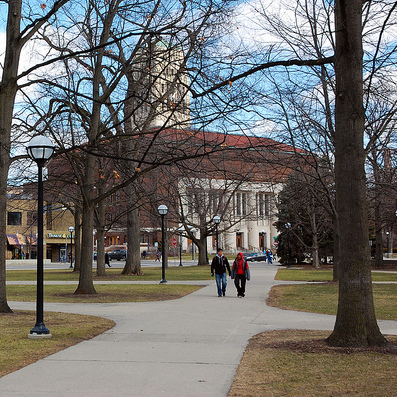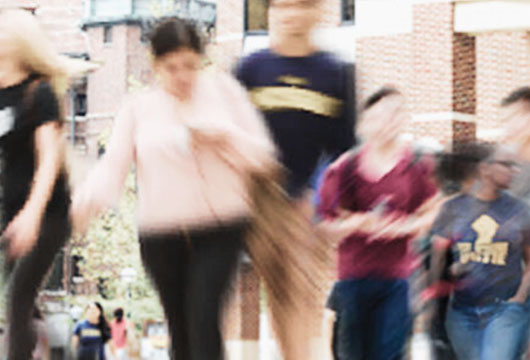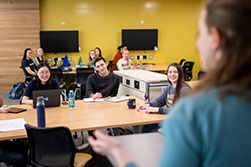| Not just the same old drill: Student-authored test questions improve critical thinking Mon, 11/30/2015
In a recent study published in the Journal of Dental Education, a team of U-M faculty from the School of Dentistry (Carlos Gonzalez-Cabezas and Margherita Fontana), School of Public Health (Olivia Anderson) and the Center for Research on Learning and Teaching (Mary Wright) investigated a new approach to mitigate these challenges. This student-centered approach to testing asks students to work in teams to design their own multiple-choice questions. Read more |
| The Sooner the Better: Rethinking the Curriculum for Early Engaged Learning Mon, 10/19/2015
In a recent Educause Review article, John Seely Brown and Richard Adler write that becoming a master in a field involves a process of both “learning about” a subject and “learning to be” a practitioner of that field. Typically, in the early years of a curriculum, students spend a lot of time mastering content, but the important work of “learning to be”–or practicing the methods of the discipline–is left until the end. When we save experiential elements such as internships or research until the final stages of a curriculum, we miss an important opportunity to engage students early with some of the most complex and compelling aspects of our discipline. How might we flip curricula in order to create more front-loaded experiences that engage students in “learning to be” earlier in their course of study? The U-M Law School offers one example. In a traditional law school curriculum, first-year students’ schedules are largely filled with doctrinal courses, which inform students about case law precedents in fields like contracts and criminal law. Only in the second year at the earliest do students usually engage in simulations, applied exercises, and clinics, where they represent real clients and practice lawyering skills in an applied setting. Last year the U-M Law School engaged in an experiment to reverse this sequence of learning experiences. They now engage second-term, first-year students (1Ls) in activities that allow them to start practicing and thinking like a lawyer earlier. The Unemployment Insurance Clinic (UIC), directed by Steve Gray, provides an opportunity for 1Ls to work with real clients on administrative law cases. Second- and third-year students (2Ls and 3Ls) serve as mentors, to supplement Gray’s supervision of their work. Students work with clients, puzzle together through litigation strategy, and take the lead in administrative hearings. Read more |
| Student Groups: One Teacher's Successes Mon, 09/28/2015
In other blog posts, CRLT has featured some effective strategies for structuring group work and guiding student pairs. Here, we highlight one U-M instructor who is applying those strategies to foster group work that has won high praise from her students and, by their account, facilitated their success with the most challenging aspects of the course. Cynthia (Cindee) Giffen, who teaches Biology 171 in the Comprehensive Studies Program, assigns her students to in-class working groups that change several times a semester. The class includes students with a diverse range of background preparation, and the groups are designed to provide a safe space for students to work through complex activities, ask questions, and make mistakes in a low-risk environment as they prepare for individual assessments. Giffen requires students to work on complex tasks in groups during class. Students receive a participation grade for their engagement in the group activities, but all written work they submit for a grade is completed individually, using their own words. Students are motivated to work in these groups, then, in part because these low-stakes interactions prepare them to submit their best work when it's time to earn a grade. Read more |
| Choosing Your Classroom Technology Policy Wed, 09/02/2015
Yet many teachers find the presence of such devices a hindrance to student learning in their classes and seek ways to limit their classroom use. Recent writings about this concern have cited the distraction of the student user, the distraction of their fellow students (with one faculty commentator comparing classroom laptop use to second-hand smoke), or the sometimes-alarming uses of social media among groups of students during class. Many faculty are also persuaded to limit laptops in the classroom by research on the benefits of notetaking by hand for those students who are able. Considering these concerns alongside the development of ever-better instructional technologies, what's the best technology policy to adopt? Of course, there is no one-size-fits-all answer to this question, and the choices you make will depend on any number of factors including your discipline, class size, pedagogical strategies, and learning goals for students. Any instructor effectively has three choices, considerations about each of which we outline below: Read more |
| Matthew Kaplan Appointed CRLT Executive Director Thu, 07/30/2015
We are very pleased to share the news that Matthew Kaplan has been appointed Executive Director of CRLT. Matt's appointment culminates a long evaluation and planning process for CRLT, which included internal and external reviews as well as a national search for a director with an inspiring vision for the Center's future. Candidates were invited to speak on "The Future of a Teaching Center in a Research University," and Matt's talk highlighted the importance of CRLT's interconnectedness. Defining the center's role as "cooperative leadership," he foregrounded our crucial collaborative relationships with partners on campus as well as our connections with the work of other university teaching centers both nationally and internationally. Matt brings to the Executive Director position over twenty years of experience in educational development, during which he has published widely on topics related to teaching and learning, faculty development, and teaching center administration. He has also held leadership roles in POD Network, the national professional organization for educational developers in higher ed, and is recognized as a key expert by teaching center colleagues nationally. He also knows our center and university very well, having worked at CRLT since 1994 and served as CRLT's interim director since January of 2014. Read more |
| Teaching Innovation Prizes awarded Wed, 05/06/2015
This year's projects all emphasized that "learning is often about doing." Hilton remarked, "From community and campus engagement to the application of new technology tools, these winning projects challenge students to actively apply what they’re learning to real situations that can be much messier than those described in textbooks. In the process, students learn to collaborate and think critically, often across disciplinary boundaries." This year's winning projects include: Read more |
| Sexual assault awareness across the curriculum Fri, 04/24/2015
Recently, student governments in both LSA and the College of Engineering have endorsed language that all faculty can include on their syllabus to provide information about campus policies as well as resources regarding sexual assault and harassment. The students leading these efforts propose that, as easily-accessible documents, syllabi are perfect places to share information such as contact numbers for crisis support services--resources that, by definition, students don't plan to need. They also emphasize the important role faculty can play in drawing attention to safety from sexual assault as a Title IX concern, in minimizing stigma against sexual assault survivors, and in demonstrating an institutional commitment to a campus where students can learn free from the threat of sexual violence. Such syllabus statements were advocated for similar reasons in a recent Chronicle of Higher Education blog. As alternatives to such a policy-focused statement, some U-M teachers choose to include syllabus statements that focus more directly on the potential impacts on student learning of sexual violence. These might emphasize the boundaries of confidentiality, or point students to resources about supporting their friends and classmates who are survivors of sexual violence. Holly Rider-Milkovich, Director of U-M's Sexual Assault Prevention and Awareness Center (SAPAC), recommends instructors include language such as the following on their syllabus or in speaking with students: Read more |
| Faculty Communities for Inclusive Teaching Mon, 03/30/2015
All around campus this term, groups of faculty are meeting to exchange and develop ideas about inclusive teaching practices. In this pilot year of the Faculty Communities for Inclusive Teaching initiative, funds from the office of the Vice Provost for Equity, Inclusion, and Academic Affairs are supporting ten different projects designed to spark faculty exchanges about how to cultivate learning environments that welcome and support students of all backgrounds and identities. This year's faculty participants represent over two dozen departments and programs, and their topics of focus range widely, from the effects of religious identity on student learning, to female underrepresentation in particular fields of study, to the dynamics of stereotype threat in science courses. A full list with brief descriptions of this year's projects can be found on this Faculty Communities for Inclusive Teaching page. Read more |
| GSIs Honored for Excellent Teaching Mon, 03/16/2015
The four Towner awardees were honored at the College of Engineering's Student Leaders and Honors Brunch on Sunday, March 15. Rackham will be hosting a public awards ceremony to honor its twenty prize-winners, along with outstanding faculty mentors, on April 13. For more information, including the names and departments of all of the winners, see the Rackham website and this College of Engineering page. Read more |
| Building pathways to your courses Thu, 02/19/2015 How do U-M undergraduates choose their courses and majors? CRLT recently investigated this question for five LSA departments by analyzing Registrar data, surveying students, and conducting student focus groups. Our findings can help faculty and programs across the university successfully inform students about their offerings and increase the numbers of students who take advantage of them. A summary of the results and recommendations can be found here.
What practices do these findings suggest if you're interested in recruiting students? Some include: Read more |


 Faculty frequently name critical thinking as one of the most important goals for student learning. However, a key challenge to cultivating critical thinking can be the development of complex assessments. This can be especially difficult in large classes, when many tests and quizzes are in a multiple-choice format.
Faculty frequently name critical thinking as one of the most important goals for student learning. However, a key challenge to cultivating critical thinking can be the development of complex assessments. This can be especially difficult in large classes, when many tests and quizzes are in a multiple-choice format.
 The
The  As U-M instructors put the finishing touches on their fall syllabi, many are pondering technology policies for their courses. Instructors across all disciplines at Michigan have developed creative ways to utilize
As U-M instructors put the finishing touches on their fall syllabi, many are pondering technology policies for their courses. Instructors across all disciplines at Michigan have developed creative ways to utilize 
 At the kickoff event of this year's
At the kickoff event of this year's  April is
April is 
 GSIs across campus are being recognized for their excellent teaching this month. CRLT warmly congratulates winners of Rackham's
GSIs across campus are being recognized for their excellent teaching this month. CRLT warmly congratulates winners of Rackham's  Some of our key findings about students' selection processes include:
Some of our key findings about students' selection processes include:



